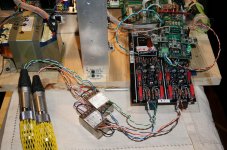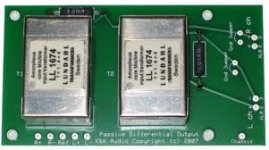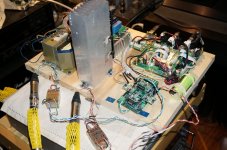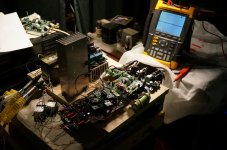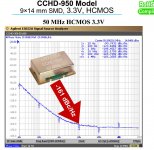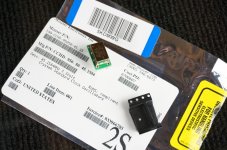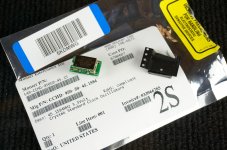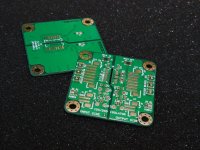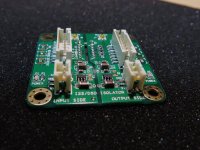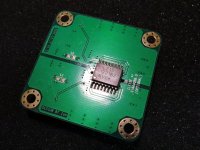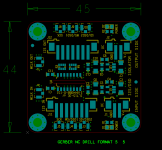LL1674 I/V
Hi Ian. I'm using LL1684's for i/v (as Andrea uses in his dac (http://www.diyaudio.com/forums/quan...018-full-assembled-board-174.html#post3649270 , the resistor is 10k). How do you compare the sound of AR's active i/v with the sound of the transformer i/v? Thanks.
Hi Ian. I'm using LL1684's for i/v (as Andrea uses in his dac (http://www.diyaudio.com/forums/quan...018-full-assembled-board-174.html#post3649270 , the resistor is 10k). How do you compare the sound of AR's active i/v with the sound of the transformer i/v? Thanks.
I ordered 178 u.fl cables from our cable supplier, but the minimal order has to be 500. I couldn't find any 178 cable with u.fl connector from Digikey or Mouse at that time.
178 has less loss. Is there anybody get it compared with normal u.fl cable?
Ian
Hi Ian
I ordered a UFL to UFL RG178 here MMCX Male to U FL IPX Cable for Mini PCI Components | eBay the seller makes custom cables and connector,I must soon receive and give you my impressions against UFL 1,37.
Hmmm, I've had some issues creep in...
In my dual mono setup, the master dac is having trouble obtaining lock. After power up, it generally works for about 4 minutes and then at the start of the next song, the L channel (the one output by the master DAC board) flickers the lock LED sometimes once a second but sometimes literally 5-10 times per second. The right channel (the slave dac board) continues to play perfectly.
If I power down the entire dac (waveio, fifo board, isolator, clock board and 2 DAC boards) then it will find a lock 50% of the time again. Perhaps coincidentally, when I power up for the first time (in the evening, say) then it works but stops soon after...heat related???
Things I have tried:
1) Swap the MCLK u.fl connectors around at both the si570 board and the DAC board ends. It appears that the connections are good and this action makes no difference
2) Swap the I2S inputs at both the dac board end and the si570 board end - again, no difference.
What has changed since it was working perfectly:
1) I've moved from directly powering the clock board with 2 duracell batteries and a jumpered regulator connector to using a 6v battery supply and a 3.3v regulator
Ideas:
1) It could be the u.fl cable length? I'm having to use 4" for the I2S and 6" for the MCLK. It could be the different lengths. I have ordered 5cm throughout...I'll report back.
Apart from returning to my original lower voltage (but direct) clock feed I'm out of ideas and would welcome suggestions as to what might be causing the lock problems.
I have almost the same case - in my dual mono BIIIse in synchronous mode powered (directly with jumper on Vin and Vout for ext.reg.) with isolator from A123 LiFePO4 (3.4V) there is no lock in 1 channel .The second channel - few seconds later loosing "lock" and sound too. What is funny - when I put the minireg in place of jumper everything is OK ! On 1 3.4V cell ! I don`t think it is related with u.fl cables ... my cables have the same length ...
@clsidxxl, Universal I2S/DSD isolator PCB
This board was designed a year ago. I didn't list it on GB. I might still have some prototype PCBs.
The attache are schematics and BOM. Please let me know if you have question.
Sorry for my late reply.
Ian
This board was designed a year ago. I didn't list it on GB. I might still have some prototype PCBs.
The attache are schematics and BOM. Please let me know if you have question.
Sorry for my late reply.
Ian
Attachments
Hi Ian. I'm using LL1684's for i/v (as Andrea uses in his dac (http://www.diyaudio.com/forums/quan...018-full-assembled-board-174.html#post3649270 , the resistor is 10k). How do you compare the sound of AR's active i/v with the sound of the transformer i/v? Thanks.
Actually it is all one. The active board is balanced jFet buffer board not an I/V board. The idea is different from the concept where mic transformers are used with resistors. In that scenario, the signal is attenuated by resistors to a minimum and than voltage is increased through transformer. I did not like that approach, but it is impossible to properly direct connect a line transformers that are 1:1 or 1:2 to a DAC. For that the best way is to connect buffer to DAC and than Lundahls to buffer. These jFet buffers designed by my friend Zen Mod are balanced without any capacitor in the line of signal and are leaving no signature to the sound. Than Lundahls are perfect match for the role of blocking of DC and safely transferring sound to the amp. The rest you now, you are listening to transformer sound as well. Unmatched detail and superb natural top end.
I was following Rasmundsen tread on transformers with great interest. I have been using Lundahls for many years, previously with AK4396 DACs, so I am very familiar with their sound and problematic involved. I am little bit suspicious to Joe's approach where signal is so much attenuated, and than amplified, so I decided to go this rout.
These Ludahls are 1+1:4+4, but in my configuration I am using them as 1+1:2+2. One way to use them without buffer is to have them reversed in configuration 4+4:1+1. That way they provide a proper loading to the DAC. With that signal is attenuated. My preference is still to use buffer in configuration I described.
Sound of transformers used after DACs is such a unbelievable transformation and improvement. I wanted to share it with Ian, who is pushing boundaries with improvements in digital domain. The difference compared to regular I/V is hard to explain or believe if not experienced.
Sorry, I meant to say "mighty Zen Mod", not just plain Zen Mod...Thanks AR2. Is the circuit for the buffer from ZenMod available for public consumption?
We have this published previously. This buffer works beautifully. It is very simple circuit, yet outstanding.Thanks AR2. Is the circuit for the buffer from ZenMod available for public consumption?
Enjoy
AR2
Attachments
This board was designed a year ago. I didn't list it on GB. I might still have some prototype PCBs.
The attache are schematics and BOM. Please let me know if you have question.
Sorry for my late reply.
Ian
How feed this board,one face,two face?and what voltage?.Thanks.
How feed this board,one face,two face?and what voltage?.Thanks.
A two-faced board is called a "Janus".
A two-faced board is called a "Janus".
Yes a mistranslation
 I should have said 'side'
I should have said 'side'but you know the answer to my question?.
Last edited:
Yes a mistranslationI should have said 'side'
It is Saturday night after all
How feed this board,one face,two face?and what voltage?.Thanks.
Double side PCB. Both DC voltage range from 3.3V to 6V.
Ian
Femto Clock is a serious misnomer targeted at insecure audiophiles. It all depends on how you measure them. The oscillators that can meet those numbers are not really available for commercial products. When I tried to get them I was told that they were a controlled commodity and I could only sell them inside the US. Typical SOTA commercial performance at 22 MHz works out to about 1.6 pS RMS jitter 10 Hz to 100 KHz. Getting it below that requires very low close in phase noise- -100 dB or less at 10 Hz. Getting that low close in phase noise is very hard and expensive. However phase noise at low frequencies has far less impact on audio. The DAC's internal processes actually limit the performance such that past a pretty accessible level (NDK, Crystek) you won't get improved performance. However good execution will trump even the best conceivable clock used badly. Ian's efforts here are among the best you will find in audio.
- Home
- Source & Line
- Digital Line Level
- Asynchronous I2S FIFO project, an ultimate weapon to fight the jitter
